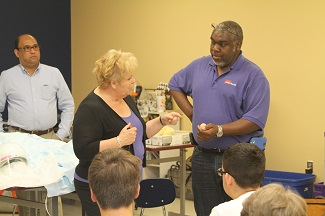 Joan Nichols and Donald Bouyer from UTMB’s GNL show students how a vaccine is made by injecting a virus into a chicken egg.
Joan Nichols and Donald Bouyer from UTMB’s GNL show students how a vaccine is made by injecting a virus into a chicken egg.While many students are now returning to school, summer students at Mosbacher Odyssey Academy had the opportunity to learn firsthand about various career opportunities in science when experts from the University of Texas Medical Branch’s Galveston National Laboratory visited their school.
Jennifer Goodman, superintendent of Odyssey Academy, arranged for the visit for rising seventh through 10th graders to provide them with a context for some of the material covered during their summer science classes.
Joan Nichols, associate director of research and operations at the GNL; Donald Bouyer, associate professor; engineer Miguel Grimaldo, assistant professor and director of institutional biocontainment resources; and Curtis Klages, senior biocontainment veterinarian and research scientist, spent the morning sharing details about their roles at the GNL, their work in both the laboratory and the field and the educational paths they took to arrive there.
The presenters made it clear that all GNL personnel, regardless of occupation, are integral members of a team that is greater than the sum of its parts. They also stressed the importance of strict adherence to safety measures.
During this interactive event, the students asked insightful questions. They knew of several diseases that scientists are developing vaccines for, including West Nile, Yellow Fever and the flu. They were fascinated to learn that chicken eggs are used in vaccines to protect people from diseases such as influenza.
Nichols explained that their goal is to learn how bacteria and viruses make people and animals sick and help stop them.
Students enjoyed Bouyer’s discussion about how viruses can be spread through bird and animal droppings, and how scientists study insects, including ticks and mosquitoes, to learn more about diseases such as Rocky Mountain Spotted Fever and chikungunya.
Klages talked about his experience as a veterinarian in the GNL and during his more than 20 years in the military. The students were excited to hear about his involvement in a top-secret military mission to prevent an Ebola outbreak stemming from monkeys that were quarantined in Virginia. The best-selling book, “The Hot Zone,” is based on this incident.
Grimaldo provided an example of the importance of infectious disease research as it relates to future travel to Mars. He explained that, given the possibility that Mars once contained running water and had a thicker atmosphere, the new generation of researchers needs to ensure that all samples returning to Earth do not contain potentially dangerous alien microorganisms.
“We need to treat Martian samples with the utmost care as we have no idea of what they might contain,” he said. “Does an autoclave that sterilizes objects with very high temperatures kill these microbes? It may not! There are many unknowns that today’s kids will need to study.”
The audience was particularly interested in the hands-on activities, most notably the personal protective equipment that researchers must wear in the high-level biocontainment labs at the GNL, including “space suits” made by the same company that manufactures suits for NASA.
“We love to visit with students when they are still figuring out what to be when they grow up,” Nichols said. “If we can inspire kids to pursue careers in science, technology, engineering or medicine by giving them a taste of why we do what we do and how interesting and even fun it can be, we’ve done our job.”